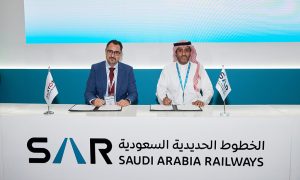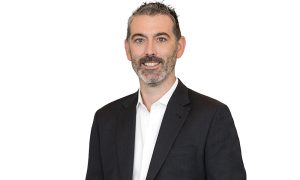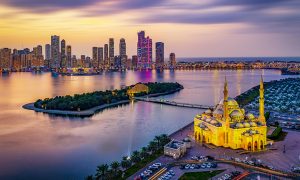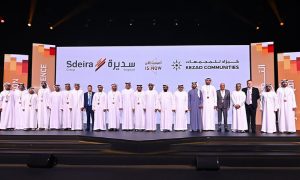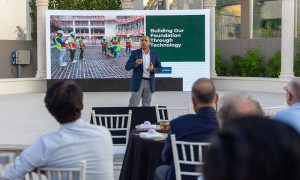After the Goldrush
When Lehman Brothers declared bankruptcy on September 15 2008 the world was thrown into chaos; not only did the banks start falling but the buildings stopped rising. Three years on, The Big Project investigates if – and if so how – the industry is recovering and what the next three years could hold On […]

When Lehman Brothers declared bankruptcy on September 15 2008 the world was thrown into chaos; not only did the banks start falling but the buildings stopped rising. Three years on, The Big Project investigates if – and if so how – the industry is recovering and what the next three years could hold
On September 15 2008 the world went into a very significant downward turn. The fall of Lehman Brothers had an effect on every single individual in the world and I saw a shift in orders literally from that day. You could see it around the world.”
Paul Foster, head of property for built asset consultancy EC Harris, first arrived in Dubai in 2007. He recalls a “fantastic place” but recalls the same frantic pace and reckless project financing that so many others did too.
As the effect of the collapse of the fourth largest investment bank in America resonated throughout the world economy, orders dried up, projects faced uncertainty and as soon as New Year 2009 HSBC was reporting contract delays and cancellations in the UAE alone had reached $75 billion.
On September 14 this year, almost three years to the day, Citigroup updated that figure to $170bn and Citigroup’s construction project tracker reports that the UAE, the region’s second largest market, accounts for 56% of the total project cancellations in the MENA region.
“The world economic down turn was deep and long and in some parts of the world there will be years to go. There may well be parts of Europe that never recover. Spain, Ireland and Greece are in serious trouble, as is the US,” Foster highlights.
“You can see some of the mistakes that were made. With hindsight everyone could have avoided them,” he continues.
“It was like an accident and the accident comes as a series of different events that becomes a single catastrophe,” says Xavier Sedaghat, head of the strategy division at JAJ Consultants.
Sedaghat also recalls the immediacy of the fallout from America and even today he says the company still doesn’t talk to clients
about equities – a once profitable and viable investment option.
“The first effects were immediate, without a question, and I think the collapse has sustained itself and gone deeper. I think there is a danger for everybody involved in the industry that it is still perceived to be a falling market,” says David Clifton, business development manager with Hill International.
“The problem you have economically with a falling market is that you commit yourself for one level, but who is going to catch the cold when it turns. That’s the steer for quite a lot of people with quite a lot of long term and large projects. There will be a level of uncertainty when pricing that risk. So the effects are still being felt. We can still feel the market going down,” he observes.
Last month, HH Sheikh Mohammed bin Rashid Al Maktoum, ruler of Dubai and vice president and prime minister of the UAE, declared the Emirate’s financial woes were over.
Inaugurating the second line of the metro with the words “Dubai is well”, he added: “A thousand hard steps forward taken by the Emirates are better than a single step backward”.
Sheikh Mohammed has publically emphasised that no projects in the health, educational or housing sectors would face delays as they “touch the life, stability and happiness of citizens”. In response to the Arab Spring similar approaches have been taken in Qatar and Saudi Arabia. The industry knows it is these projects that will buoy the market.
“The broad brush view is there’s not a lot happening in the old markets, but there is great excitement for us looking at infrastructure and social housing,” says Clifton, naming Qatar, Bahrain, Saudi Arabia and Iraq as key locations for such projects.
“Anything that is high end in terms of residential or commercial is slow, and I can’t see that moving particularly quickly, unless there is a surprise form somewhere,” he adds.
“The recovery around the world is mixed,” asserts Ted Garrison, author of Construction 3.0.
“However, there appears to a significant upturn in the Middle East and in part, this is due to the investment in infrastructure.
To illustrate the comparison the GCC is expected to have a larger construction market in 2012 than the United States. The GCC primed the pump with infrastructure spending and this will lead to more commercial type construction,” he predicts, explaining the average industry contribution towards GDP ranges from 6% to 12% and that this can be one of the most reliable economic indicators of recovery.
“In essence, infrastructure spending is one of the best investments possible,” he continues.
Live and learn
As an authority on successful business models nin the industry, Garrison’s Construciton 3.0 strategy has been adopted by businesses worldwide, not only in a bid to streamline efficiency, but to simply survive.
Yet he is the first to admit the strategy is not revolutionary; it is based on principles (see below) first written in Sun Tzu’s book The Art of War, 2500 years ago. But they are principles that were abandoned during the gold rush.
“The reality is the construction industry has serious flaws in the way it conducts business. Reports done in the United States, United Kingdom, Australia, Canada and Singapore all report that the current approach to construction creates barriers to fixing the current problems,” he begins, naming those barriers to be lack of leadership, adversarial relationships, parochialism, fragmentation of the industry, inadequate owner involvement, increasing scarcity of skilled labour and liability.
“What this has done is increase the cost of construction through inefficiency and waste. It is estimated that the amount of waste in the construction industry is at least 30% and could be as high as 50%,” he continues.
Naming the design-bid-build approach as not only the most flawed but a barrier to even greater growth in the regional industry, he says this widely adopted method is inefficient and encourages both fragmentation and a lack of accountability.
Advising that the concept of design-build and integrated project delivery could improve the economics of projects by up to 30% he says the greatest challenges now are simply to cut costs and improve performance.
“Without overly simplifying things, these two issues act as a break on the industry. In essence, instead of trying to get the low bid
price on every project, which is very inefficient, the industry would be better creating integrated teams of experts that could focus on eliminating waste and inefficiencies.
“While this approach is counter-intuitive to many, it has been the formula for virtually every other industry’s improved productivity and cost reductions,” he continued.
Using Chrysler as an example, Garrison explains the company’s change in format unveiled that working with the best qualified vendors for each element of production, rather than seeking the lowest bid every year, increased the price of individual parts but brought down the overall cost of the car.
“It wasn’t the cost of the parts that was the problem, it was the cost of the interactions and problems due incompatible parts. This is exactly the same problem the construction industry is experiencing,” he summarises.
“The answer is greater collaboration. What other industries have done over the last 50 years to significantly improve their productivity is what’s often referred to as managing the downside supply chain.
“This eliminates waste and inefficiency because the participants create collaborative teams to attack inefficiency and waste. This has been very effectively worked in the other industries and the construction industry must adapt this approach. The savings would be significant,” he asserts.
The legacy of boom and bust
While many are quick to criticise the behaviour that led to the current situation, the legacy of the boom period includes some of the most significant engineering and design feats in the modern world; Burj Khalifa, Burj Al Arab, Qatar’s Museum of Islamic Art and mega projects such as KAEC and Abu Dhabi’s various island projects, to name a few.
“This is a region that is very proud and they want to present what they can do in a very visual way through buildings, and I think there are some of the most beautiful buildings in the world here. The legacy of what those boom years delivered was a lot of really good buildings,” says Foster, naming Abu Dhabi’s central market and Doha’s signature architecture among his personal favourites.
Elaborating that the abstract legacy is a mature market, Foster continues to observe a shift in focus that has seen greater emphasis
placed on the management of the projects completed during the boom.
As the investors and developers behind the projects face severe delays on ROI they are now looking how best to maximise profit over the whole project lifecycle, thus taking greater interest in how the asset is managed.
“There are distressed asset opportunities that weren’t there before where developers, lenders and investors are having to step in to develop out their investments with developers who perhaps haven’t been able to.
“There is a very particular set of skills to enable that to move up in the right way, otherwise you don’t realise the value quickly,” he explains, adding that such a shift in attitude has also aided the green movement that is being driven by market demand for cost efficient assets that are not only easy on the environment but the health of occupiers also. His observations are echoed by Sedaghat
“New regulations are focussed on the management of buildings and it is positive that this is now linked to the government. Dubai has moved from a state of building to a state of managing because now it’s built what do we do?
“The guy who put his money in this building has to keep it for as long as he can to get his money back. So this is where the market is going now, asset management and investor expectation management,” he says.
“Dubai will always be attractive; because of the tax cuts, because of the sun, because of the tourism because of the leaders.
“It’s pure ambition, it’s pure capitalism. The fundamentals are difficult to understand right now because the market has been growing so fast,” Sedaghat adds.
Foster also observes an increased focus on health and safety, praising the emerging consistency with standards is Japan, Hong Kong, Western Europe and North America.
 Future focus
Future focus
The only hesitation shown by the experts when asked about their predictions for the future, are how far ahead they can predict. While some refuse to look beyond six months, others are anticipating market behaviour as far as five and ten years down the line, when Qatar’s World Cup projects and many of Saudi Arabia’s mega projects are due for completion; including the world’s next tallest building, Kingdom Tower.
“There is a strong lender and investor market here, so while we have seen a lot of the European banks significantly reduce their operations you can see the regional lenders and investors are strong on the whole,” Foster reports.
“You can see they are looking at external investment, taking advantage of markets such as London and New York. You can see them going into these markets where there is property at discounted values,” he adds.
Closer to home the countdown to stability appears to have begun.
In fact as Dubai pays off its maturing $4bn debt facility, other Emirates embark on megaprojects and neighbouring GCC countries announce staggering fiscal budgets, ambitious plans to build the world’s next tallest tower and a string of new stadia for a World Cup tournament, is it logical to think the worst is over?
“The government has a track record of spending on things, developing the roads, the airports the airlines. Here, buildings work properly but the key questions we are hearing from our corporate clients is where to recruit in the Middle East, and the only answer to that is still Dubai,” says Nicholas Maclean, managing director of CB Richard Ellis Middle East.
“You can look around the market place and find the skill sets you need, and that’s very different to the situation in many of the other market places,” he continues.
Having recently been awarded the contract for the global marketing of Dubai World Centre – a development intended to “cement the UAE’s position as the logistics hub of the region” – the firm will be speaking to potential investors in the UK, US, Europe and Far East to attract investment in DWC’s surrounding developments.
“This is a long term project so the first thing we have to do is introduce the project to people in the aviation or manufacturing industry.
“There was a flurry of activity when it was under construction then things went quiet.
Now we have to re-energise the enthusiasm for that airport and if we can do that I think it’ll sell itself because the concept is strong
and the information the government is providing in terms of growth and logistics here speaks for itself.
“We just need to get the message across,” he continues.
Commenting on the future, Maclean ultimately concludes recovery still lies in the hands of international markets.
“We can do certain things to kick start the developers and investors but ultimately we are dependent on what happens in the outside world and until that clarity is here I don’t see a magnificent step forward.”
Clifton adds: “In certain areas I think it’s still going down. The UAE is still sliding in terms of projects, in terms of high priced projects, in terms of the sales market.
“I don’t think that will change for a while and I think Dubai is pretty flat. Oman probably has some growth but it’s nothing explosive.
Obviously we see a pipeline in Qatar and a pipeline in Saudi,” he says.
Survival of the fittest
“To not only survive the downturn, but to take advantage of the upturn, contractors should be improving their supply chain management,” says Garrison.
“Even if they are forced to compete on design-bid-build projects they can still improve the supply chain management,” he adds, reporting the key area for improvement is the inclusion of trade specialists at the design phase of projects to ensure maximum constructability and efficiency.
“This is potentially the largest benefit, but it does require participation by the owner,” he advises.
Despite seeing evidence of investment in the region, Maclean’s outlook is conservative.
Saying that investment is evident in the region, Maclean’s outlook is measured; he sees benefits in Dubai’s infrastructure logistics and he predicts growing demand once political situations have calmed. There are also benefits for companies looking to position themselves for the emerging opportunities in Iraq.
“It has been a tough two years but especially in Dubai we are beginning to see some light at the end of the tunnel. It is remarkable that since the end of the summer this year people have come back from holiday wanting to do business,” he says.
“The region is a cluster of different hotspots, it isn’t a whole entity,” says Sedaghat.
“All the hotspots have niche opportunities and if you are present in a market you are able to access and take advantage of it. In terms of investment I see Qatar as the leaders in the region,” he adds.
Foster, who since his last visit in 2010 has witnessed notable progress in projects that were then stalled, maintains there is evidence the market is “on the turn”.
“We at EC Harris are growing in strength ourselves so that has to be an indication of where the market is.
“I expect to see a much greater emphasis on public private partnerships, as opposed to PFI.
If you look at the health care work in Kuwait, the Hajj terminal in Mecca they are fantastic examples of PPP and demonstrate that this region is able to do some things that are really grown up.
“We are seeing a definite shift to complicated finance structures with complicated employer requirements and performance payment mechanisms, which is not just about how to build buildings quickly, but how that asset will be handled over a 50 or 60 year life,” he concludes.
“We are seeing a definite shift to complicated finance structures with complicated employer requirements and performance payment mechanisms”
The key principles to addressing the challenges facing the construction industry, by Ted Garrison:
1) Effective Leadership
2) Strategic Thinking
3) Value-driven Operations
4) Increased Innovation
5) Increased Collaboration
6) Effective Risk Management
7) Effective Operations (Lean)
8) Effective Use of Technology
9) Measurement
The new markets
David Van Graan, vice president of Sales for MAN Trucks
“Saudi Arabia is the solid hub for performance for us at the moment, but we have all had to become more prudent in our approach to the market. When economies are tough you still have to develop.
“While we eye other areas and sectors our customers have become really prudent and that knocks back.
“We have to look where we are at now in the context of 2008. There are natural business cycles but the trend was abnormal in 2007 and 2008. We have had to take stock again and analyse where the most realistic market and requirements were at that time.”
David Semple, vice president of sales for Manitowoc Cranes
“Saudi Arabia is certainly the biggest construction site in the world, and it may not have the world cup but it has 25 million people.
“The demand they create will always outstrip Qatar.”
Arif Kalam, vice president of sales and marketing, Lafarge
“Iraq is an interesting market. Business wise, it has given us fourfold this year what it has given us in previous years. We see many of the long term government projects coming to fruition and those companies that stood the test of time will be there in the boom period that’s coming.”

